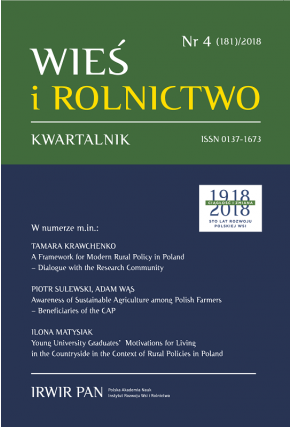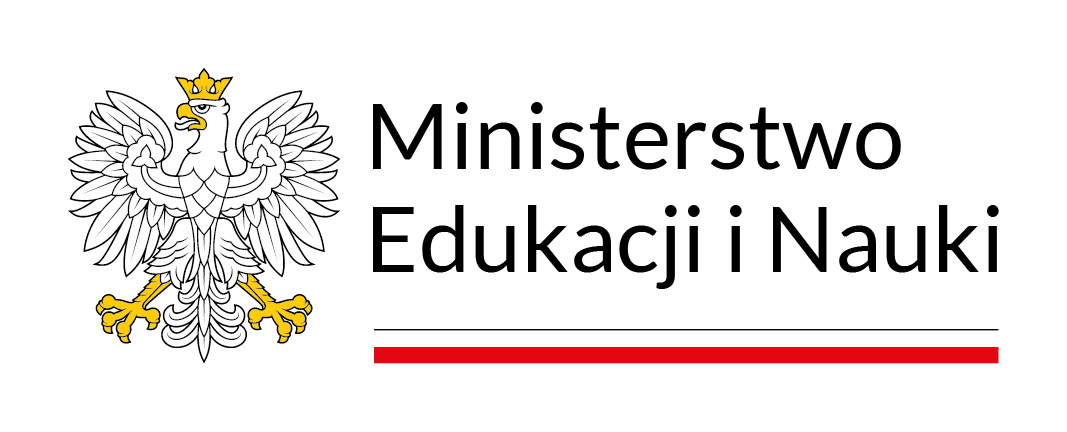Świadomość trwałego rolnictwa wśród polskich rolników – beneficjentów Wspólnej Polityki Rolnej
DOI:
https://doi.org/10.53098/wir042018/03Słowa kluczowe:
polityka rolna, trwałość, świadomość rolników, dobra publiczneAbstrakt
Głównym celem badań była ocena świadomości zagadnień związanych z „trwałym rolnictwem” wśród polskich rolników korzystających ze wsparcia w ramach WPR na podstawie stosowanych przez nich wybranych praktyk rolniczych. Badaniami objęto reprezentatywną próbę 600 rolników uczestniczących w polskim FADN. Dane dostępne w bazie FADN zostały uzupełnione danymi uzyskanymi w trakcie bezpośrednich wywiadów z rolnikami. Wartość parametrów wskazujących na stopień trwałości gospodarstw przeanalizowano w zależności od typu i wartości otrzymywanego wsparcia finansowego z UE. Wyniki przeprowadzonych analiz wskazują, że przeciętnie najwyższymi parametrami trwałości charakteryzowały się gospodarstwa korzystające z programów rolno-środowiskowych i jednocześnie położone na obszarach ONW, podczas gdy najniższy poziom tych parametrów obserwowano w pozostałych jednostkach położonych na ONW. Analiza różnic między grupami gospodarstw wyodrębnionymi na podstawie łącznej wartości dopłat wykazała, że jednostki, które otrzymywały bezwzględnie wyższe wsparcie charakteryzowały się wyższym poziomem wskaźników trwałości. Na podstawie przeprowadzonych analiz stwierdzono, że pobieranie większego i bardziej zróżnicowanego wsparcia pozytywnie wpływa na poziom trwałości gospodarstw.
Bibliografia
Anand S., Sen A. (1994). Sustainable Human Development: Concepts and Priorities. Human Development Report Office (HDRO), United Nations Development Programme (UNDP), Human Development Occasional Papers (1992–2007).
Bardy R., Rubens A., Massaro M. (2015). The systemic dimension of sustainable devel- opment in developing countries. Journal of Organisational Transformation & Social Change, 12 (1), 22–41. DOI: https://doi.org/10.1179/1477963314Z.00000000033
Barreiro-Hurle J., Espinosa-Goded M., Dupraz P. (2010). Does intensity of change matter? Factors affecting adoption of agri-environmental schemes in Spain. Journal of Environmental Planning and Management, 53 (7), 891–905. DOI: https://doi.org/10.1080/09640568.2010.490058
Burton R.J.F., Paragahawewa U.H. (2011). Creating culturally sustainable agrienvironmental schemes. Journal of Rural Studies, 27, 95–104. DOI: https://doi.org/10.1016/j.jrurstud.2010.11.001
Ciegis R., Ramanauskiene J., Martinkus B. (2009). The concept of sustainable development and its use for sustainability scenarios. Inzinerine Ekonomika – Engineering Economics, 62 (2), 28–37.
Cochran W.G. (1977). Sampling Techniques. New York, Chichester, Brisbane, Toronto, Singapore: John Wiley & Sons.
Defrancesco E., Gatto P., Runge F., Trestini S. (2008). Factors affecting farmers’ participation in agri-environmental measures: A northern Italian perspective. Journal of Agricultural Economics, 59 (1), 114–131. DOI: https://doi.org/10.1111/j.1477-9552.2007.00134.x
Duer I., Fotyma M., Madej A. (2002). Kodeks Dobrej Praktyki Rolniczej. Warsaw: Ministerstwo Rolnictwa i Rozwoju Wsi, Ministerstwo Środowiska.
Dumanski J., Terry E., Byerlee D., Pieri C. (1998). Performance Indicators for Sustainable Agriculture. Discussion Note. Washington, D.C.: The World Bank.
Ecorys (2017). Modernizing and simplifying the CAP: Summary of the results of the public consultation. Brussels: European Commission – DG for Agriculture and Rural Development.
Emas R. (2015). The Concept of Sustainable Development: Definition and Defining Principals. Brief for GSDR.
EC (European Commission) (2017). Communication from the Commission to the European Parliament, the Council, the European Economic and Social Committee and the Committee of the Regions, the Future of Food and Farming. COM(2017)713 final. Brussels.
FADN (Farm Accountancy Data Network) (2008). Plan of sampling for Polish FADN. Warsaw: Instytut Ekonomiki Rolnictwa i Gospodarki Żywnościowej – Państwowy Instytut Ba- dawczy.
Fleury P., Seres C., Dobremez L., Nettier B., Pauthenet Y. (2015). “Flowering Meadows”. A result-oriented agri-environmental measure: Technical and value changes in favour of biodiversity. Land Use Policy, 46, 103–114. DOI: https://doi.org/10.1016/j.landusepol.2015.02.007
Green G.P., Heffernan W.D. (1987). Soil erosion and perception of the problem. Journal of Rural Studies, 3 (2), 151–157. DOI: https://doi.org/10.1016/0743-0167(87)90030-1
Greiner R., Patterson L., Miller O. (2009). Motivations, risk perceptions and adoption of conservation practices by farmers. Agricultural Systems, 99 (2-3), 86–104. DOI: https://doi.org/10.1016/j.agsy.2008.10.003
Hansen J.W. (1996). Is agricultural sustainability a useful concept? Agricultural Systems, 50, 117–143. DOI: https://doi.org/10.1016/0308-521X(95)00011-S
Hayati D. (2017). A Literature Review on Frameworks and Methods for Measuring and Monitoring Sustainable Agriculture. Technical Report, 22. Rome: Global Strategy.
Herzele A., Gobin A., Van Gossum P., Acosta L., Waas T., Dendoncker N., de Frahan
B. (2013). Effort for money? Farmers’ rationale for participation in agri-environment measures with different implementation complexity. Journal of Environmental Management, 131, 110–120. DOI: https://doi.org/10.1016/j.jenvman.2013.09.030
Ikerd J. (1997). Understanding and managing the multi-dimensions of sustainable agriculture. Paper presented at the Southern Region Sustainable Agriculture Professional Development Program Workshop, SARE Regional Training Consortium, Gainesville, FL, January 15th, 1997.
Kalton G. (1983). Introduction to Survey Sampling. Newbury Park, London, New Delhi: Sage Publications. DOI: https://doi.org/10.4135/9781412984683
Kiełbasa B., Pietrzak S., Ulén B., Drangert J.O., Tonderski K. (2018). Sustainable agriculture: The study on farmers’ perception and practices regarding nutrient management and limiting losses. Journal of Water and Land Development, 36 (1–3), 67–75. DOI: https://doi.org/10.2478/jwld-2018-0007
Kington E.A., Pannell D.J. (2003). Dryland salinity in the Upper Kent River catchment of Western Australia: Farmer perception and practices. Australian Journal of Experimental Agriculture, 203 (43), 19–28. DOI: https://doi.org/10.1071/EA01058
Krasowicz S., Kuś J. (2010). Kierunki zmian w produkcji rolniczej w Polsce do roku 2020: Próba prognozy. Zagadnienia Ekonomiki Rolnej, 3 (324), 5–18.
Lastro-Bravo X.B., Hubbard M.C., Garrod G.D., Tolon-Becerra A. (2015) What drives farmers’ participation in EU agri-environmental schemes? Results from a qualitative meta-analysis. Environmental Science & Policy, 54, 1–9. DOI: https://doi.org/10.1016/j.envsci.2015.06.002
Latruffe L., Diazabakana A., Bockstaller Ch., Desjeux Y., Finn J., Kelly E., Ryan M., Uthes S. (2016). Measurement of sustainability in agriculture: A review of indicators. Studies in Agricultural Economics, 118 (3), 123–130. DOI: https://doi.org/10.7896/j.1624
Long G. (2015). The idea of universality in the sustainable development goals. Ethics & International Affairs, 29 (2), 203–222. DOI: https://doi.org/10.1017/S0892679415000076
Majewski E. (2001). Jakość zarzadzania w gospodarstwach rolniczych w Polsce w świetle badań. Warsaw: Wydawnictwo Szkoły Głównej Gospodarstwa Wiejskiego.
Majewski E. (2002). Ekonomiczno-organizacyjne uwarunkowania rozwoju Systemu Integrowanej Produkcji Rolniczej (SIPR) w Polsce. Warsaw: Wydawnictwo Szkoły Głównej Gospodarstwa Wiejskiego.
Majewski E. (2008). Trwały rozwój i trwałe rolnictwo: Teoria a praktyka gospodarstw rolniczych. Warsaw: Wydawnictwo Szkoły Głównej Gospodarstwa Wiejskiego.
Majewski E., Bednarek A., Bagel M., Hurej M., Łabętowicz J., Radecki A., Skomiał J., Straszewski S. (1997). System Integrowanej Produkcji Rolniczej: Wytyczne i instrukcja wdrożeniowa. Warsaw: Wydawnictwo Szkoły Głównej Gospodarstwa Wiejskiego.
McCracken M.E., Woodcock B.A., Lobley M., Pywell R.F., Saratsi E., Swetman R.D., Mortimer S.R., Harris S.J., Winter M., Hinsley S., Bullock J.M. (2015). Social and ecological drivers of success in agri-environment schemes: The roles of farmers and environmental context. Journal of Applied Ecology, 52 (3), 696–705. DOI: https://doi.org/10.1111/1365-2664.12412
Morris J., Mills J., Crawford I.M. (2000). Promoting farmer uptake of agri-environment schemes: the countryside stewardship arable options scheme. Land Use Policy, 17 (3), 241–254. DOI: https://doi.org/10.1016/S0264-8377(00)00021-1
Neyman J. (1934). On the two different aspects of the representative method: The method of stratified sampling and the method of purposive selection. Journal of the Royal Statistical Society, 97(4), 558–625. DOI: https://doi.org/10.2307/2342192
OECD (Organisation for Economic Co-operation and Development) (2018). OECD Rural Policy Reviews: Poland 2018. OECD Rural Policy Reviews. Paris: OECD Publishing.
Okumah M., Martin-Ortega J., Novo P. (2018). Effects of awareness on farmers’ compliance with diffuse pollution mitigation measures: A conditional process modeling. Land Use Policy, 76, 36–45. DOI: https://doi.org/10.1016/j.landusepol.2018.04.051
Pannell D.J., Schilizzi S. (1998). Sustainable agriculture: A matter of ecology, equity, economic efficiency or expedience? Journal of Sustainable Agriculture, 13 (4), 57–66. DOI: https://doi.org/10.1300/J064v13n04_06
Pretty J. (1996). Regenerating agriculture, policies and practices for sustainability and selfreliance. Washington, D.C.: National Academy Press.
Pretty J. (2008). Agricultural sustainability: concepts, principles and evidence. Philosophical Transactions of the Royal Society B: Biological Sciences, 363, 447–465. DOI: https://doi.org/10.1098/rstb.2007.2163
Rigby D., Caceres D. (2001). Organic farming and the sustainability of agricultural system. Agricultural Systems, 68 (1), 21–40. DOI: https://doi.org/10.1016/S0308-521X(00)00060-3
Ruto E., Garrod G. (2009). Investigating farmers’ preferences for the design of agri-environmental schemes: A choice experiment approach. Journal of Environmental Planning and Management, 52 (5), 631–647. DOI: https://doi.org/10.1080/09640560902958172
Sabiha N., Salim R., Rahman S., Rola-Rubzen M.F. (2016). Measuring environmental sustainability in agriculture: A composite environmental impact index approach. Journal of Environmental Management, 166, 84–93. DOI: https://doi.org/10.1016/j.jenvman.2015.10.003
Sadok W., Angevin F., Bergez J., Bockstaller C., Colomb B., Guichard L., Reau R., Dore T. (2008). Ex ante assessment of the sustainability of alternative cropping systems: Implications for using multi-criteria decision-aid methods. A review. Agronomy for Sustainable Development, 28 (1), 163–174. DOI: https://doi.org/10.1051/agro:2007043
Spindler E. (2013). The history of sustainability, the origins and effects of a popular concept. In: I. Jenkins, R. Schröder (eds.), Sustainability in Tourism (pp. 9–31). Wiesbaden: Springer Gabler. DOI: https://doi.org/10.1007/978-3-8349-7043-5_1
Stanny M., Czarnecki A. (2011). Zrównoważony rozwój obszarów wiejskich Zielonych Płuc Polski: Próba analizy empirycznej. Warsaw: Instytut Rozwoju Wsi i Rolnictwa Polskiej Akademii Nauk.
Tatlıdil F.F., Boz I., Tatlidil H. (2009). Farmers’ perception of sustainable agriculture and its determinants: A case study in Kahramanmaras province of Turkey. Environment, Development and Sustainability, 11 (6), 1091–1106. DOI: https://doi.org/10.1007/s10668-008-9168-x
UNEP (United Nations Environment Programme), UNHR (United Nations Human Rights) (2015). Universality in the Post 2015 Sustainable Development Agenda. UNEP Post 2015, Note 9. OHCHR Human Rights and Post 2015.
UN (United Nations) (2015). Resolution adopted by the General Assembly on 25 Septem- ber 2015. Transforming our world: the 2030 Agenda for Sustainable Development. A/RES/70/1. Washington D.C.: United Nations General Assembly.
Werf van der H.M.G., Petit J. (2002). Evaluation of the environmental impact of agriculture at the farm level: a comparison and analysis of 12 indicator-based methods. Agriculture, Ecosystems and Environment, 93 (1-3), 131–145. DOI: https://doi.org/10.1016/S0167-8809(01)00354-1
Wilson G.A., Hart K. (2000). Financial imperative or conservation concern? EU farmers’ motivations for participation in voluntary agri-environmental schemes. Environment and Planning A: Economy and Space, 32 (12), 2161–2185. DOI: https://doi.org/10.1068/a3311
Wilson G.A., Hart K. (2002). Farmer participation in agri-environmental schemes: Towards conservation oriented thinking? Sociologia Ruralis, 41 (2), 254–274. DOI: https://doi.org/10.1111/1467-9523.00181
WCED (World Commission on Environment and Development) (1987). Our Common Future. Oxford: Oxford University Press.
Zhen L., Routrayb J., Zoebischc M., Chend G., Xiea G., Chenga S. (2005). Three dimensions of sustainability of farming practices in the North China Plain: A case study from Ningjin County of Shandong Province, PR China. Agriculture, Ecosystems and Environment, 105, 507–522. DOI: https://doi.org/10.1016/j.agee.2004.07.012











